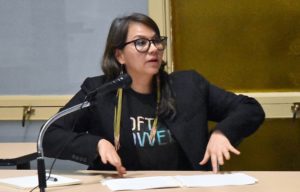Performance to celebrate the return of cultural belongings

By Kelly Anne Smith
NORTH BAY— An international contemporary artist challenges her audiences to reflect on a museum’s role in Indigenous history. With song, dance, video and poetry, Tanya Lukin Linklater celebrates artifacts repatriated from colonialism. Those objects she tenderly refers to as cultural belongings.
At Nipissing University’s Fine Arts Monestary Hall, Lukin Linklater talked about her research as a doctoral candidate at Queen’s University and her artistic practice during her public lecture We Wear One Another. Lukin Linklater is also the Director of Enji giigdoyang – Office of Indigenous Initiatives at Nipissing University.
In the packed room, Lukin Linklater educated while her video played of Ceinwen Gobert and Danah Rosales performing a dance against a frozen Lake Ontario backdrop during an open rehearsal in March 2019. We also heard the amplified violinist Laura Ortman in We Wear One Another, the commissioned work for the Soundings Festival at the Isabel Bader Centre for the Performing Arts.
Lukin Linklater is Alutiiq/Sugpiaq from the Native Villages of Afognak and Port Lions, Alaska. She speaks about the work’s beginnings.
“It speaks a little bit to my lived experience as an Alutiiq person and my experiences working within museums in relation to museum collections. And some of my thinking about performance.”
Lukin Linklater explains that in 1994, the Smithsonian published Reckoning with the Dead: The Larsen Bay Repatriation and Smithsonian Institution, a book that examined a test case of repatriation that coincided with and was instrumental in the passage of the Native American Graves Protection and Repatriation Act, 1990.
Ancestral remains of 1,000 people were removed from Alutiiq lands in 1932. Repatriation took place in 1990 when the human remains were returned to the Native Village of Larsen Bay for reburial from the Smithsonian Museum of Natural History.
She credits the hard work of Gordon L. Pullar, the first anthropologist from the community.
“The former executive director of the Kodiak Area Native Association and scholar documented work over many years of Alutiiq members on Kodiak Island. And Alutiiq ancestors. Those are my ancestors.”
In the 1980s, Alutiiq youth were offered employment through the Kodiak Area Native Association summer youth employment program to focus on archeological projects.
“The impetus behind the program was to help Alutiiq youth understand the strength of their ancestors; what their lives may have been like prior to Russian contact. It was part of a larger movement of cultural revitalization on Kodiak Island,” explains Lukin Linklater. “It took advocacy at the local, state and national levels over many years, including the support of local and state leadership and the Native American Rights Fund, as well as Alutiiq testimony and participation in congressional hearings regarding on what was to become NAGPRA or the Native American Graves Protection and Repatriation Act for the Smithsonian to finally return the remains…This Alutiiq history and its entanglement with archeology, anthropology, museums, community and wellness as KANA (or the Kodiak Area Native Association) as a health organization is very present for me as an Alutiiq person.”
Lukin Linklater was the first youth intern at the new Alutiiq Museum. She recently realized the “specificity of this history in relation to Alutiiq efforts in the early 1980s to steer Alutiiq youth towards our ancestors and away from the destructive forces of colonialism’s material and bodily consequences in our communities in the forms of substance abuse, domestic violence and suicide.”
She says the last traditional Alutiiq Chief on the island, Larry Matfay, taught traditional songs and dances. People relearned how to sew and carve regalia, sing the Alutiiq language and perform gestural storied dances.
A relative of Lukin Linklater travelled to museums to visit Alutiiq cultural belongings to study the material forms for replication in the making of masks, baskets and other cultural belongings.
Lukin Linklater ponders the awakening of cultural belongings through repatriation. When she encountered a rain gut parka in a New York institution, she imagined notations for performance. She also thought about the dedicated sewing process in its beginnings on St. Lawrence Island in the Bering Sea. The constant maintenance of a rain gut parka ensured a waterproof garment, essential for the survival of the hunter.
In the video, there is a slow dolly of the traditional rain gut parka, the cultural belonging being danced to. The dance of sections begins in couplets because the beaks and feathers on the rain gut parka are sewn in twos.
“The dancers also worked with segmentation of the body because they were thinking about the sections of the gut skins [whale] that were sewn together.”
Lukin Linklater embeds everyday movement in the choreography to represent a shift to include pedestrian movement in dance in the 1960s. She also considers that within Alaska Native dance, Elders, children and everyone in between are welcome to dance. Everyone can dance.
Stay tuned for works Slow Scrapes and A Glossary of Insistance coming soon from Tanya Lukin Linklater.

